Global No-code AI Platform Market, By Component, By Deployment Mode, By Technology, By Organization Size, By Industry Vertical, By Region & Segmental Insights Trends and Forecast, 2024 – 2034
- Industry: Technology
- Report ID: TNR-110-1219
- Number of Pages: 420
- Table/Charts : Yes
- July, 2024
- Base Year : 2024
- No. of Companies : 10+
- No. of Countries : 29
- Views : 10159
- Covid Impact Covered: Yes
- War Impact Covered: Yes
- Formats : PDF, Excel, PPT
A No-code AI platform is a tool or service that enables users to build, deploy, and manage artificial intelligence (AI) models without needing to write any code. These platforms are designed to be user-friendly, allowing people with little to no programming experience to leverage AI technologies for various applications.
No-code AI platform market is experiencing rapid growth, driven by the increasing demand for democratizing AI and machine learning capabilities. Key drivers include the rising need for automation across industries, a shortage of skilled data scientists, and the push for digital transformation initiatives. Organizations are leveraging these platforms to enhance productivity, reduce time-to-market, and streamline operations without requiring extensive technical expertise.
Key trends shaping the market include advancements in AutoML, integration of AI capabilities into business processes, and the proliferation of cloud-based solutions. The emphasis on user-friendly interfaces and pre-built models is accelerating adoption across small and medium-sized enterprises, further propelling market expansion. In Terms of Revenue, the Global No-code AI Platform Market was Worth US$ 3.9 Bn in 2023 and is Anticipated to Witness a CAGR of 31.5% During 2024 – 2034.

Opportunities in No-code AI Platform Market
Expansion in Small and Medium-Sized Enterprises (SMEs)
SMEs often lack the resources and technical expertise to develop AI solutions from scratch. No-code AI platforms provide these businesses with accessible, cost-effective tools to implement AI-driven strategies, enhancing their competitiveness. By automating routine tasks, optimizing operations, and improving decision-making processes, SMEs can achieve greater efficiency and innovation. As more SMEs recognize the value of AI, the demand for intuitive, no-code solutions will surge, driving market growth. Additionally, tailored marketing and educational initiatives can further accelerate adoption, positioning no-code AI platforms as essential tools for SME digital transformation.
Integration with IoT and Edge Computing
As IoT devices generate vast amounts of data, the ability to analyze and act on this data in real-time becomes crucial. No-code AI platforms can empower businesses to develop intelligent IoT solutions quickly, without extensive programming knowledge. This integration facilitates real-time data processing and decision-making at the edge, enhancing efficiency and reducing latency. Industries such as manufacturing, healthcare, and logistics can particularly benefit from this synergy, driving demand for no-code AI solutions. As IoT adoption continues to grow, the market for integrated no-code AI and IoT solutions is poised for substantial expansion.
No-code AI Platform Market Segmentation by Component, Deployment Mode, Technology, Organization Size, Industry Vertical, Region
Platform segment by component dominated the no-code AI platform market, capturing a significant revenue share of 79.5% over the forecast period. This dominance is attributed to the comprehensive capabilities offered by these platforms, including seamless integration, user-friendly interfaces, and extensive automation features. Businesses are increasingly adopting no-code AI platforms to streamline their AI development processes, reduce dependency on specialized technical talent, and accelerate deployment timelines. The platforms’ ability to provide end-to-end solutions—from data integration and model building to deployment and monitoring—drives their widespread adoption across various industries. As organizations prioritize digital transformation and seek efficient, scalable AI solutions, the platform segment is poised to maintain its leading market position.
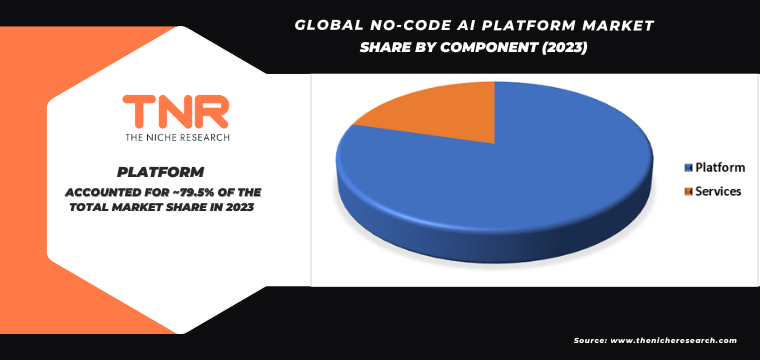
On premises segment by deployment mode is set to dominate the no-code AI platform market, commanding a substantial revenue share of 69.7% over the forecast period. This preference is driven by the need for enhanced data security, control over sensitive information, and compliance with stringent regulatory requirements. Businesses, particularly in sectors like finance, healthcare, and government, opt for on-premises deployment to ensure data privacy and mitigate risks associated with cloud-based solutions. On-premises deployment offers greater customization and integration capabilities with existing IT infrastructure. As organizations prioritize safeguarding their data while leveraging advanced AI tools, the on-premises segment is expected to maintain its significant market share and continue driving growth in the no-code AI platform market.
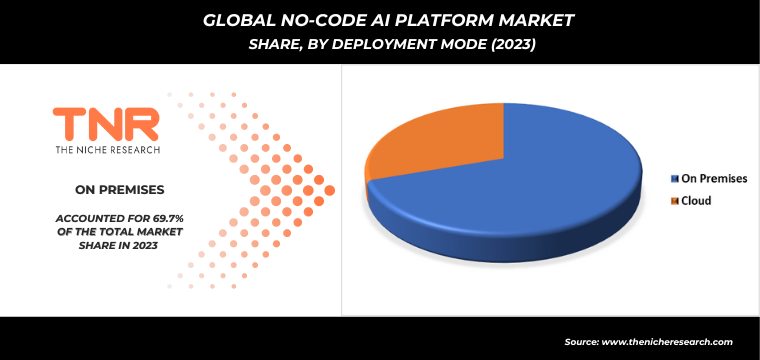
Computer vision segment is anticipated to be the fastest-growing technology in the no-code AI platform market, capturing a substantial revenue share of 32.6% over the forecast period. This rapid growth is driven by the increasing demand for automated image and video analysis across various industries, such as retail, healthcare, and manufacturing. No-code AI platforms enable businesses to develop and deploy computer vision applications quickly, without requiring extensive technical expertise. Applications range from facial recognition and object detection to quality control and surveillance. As organizations seek to enhance operational efficiency and customer experiences, the adoption of no-code computer vision solutions is set to surge, fueling market expansion.
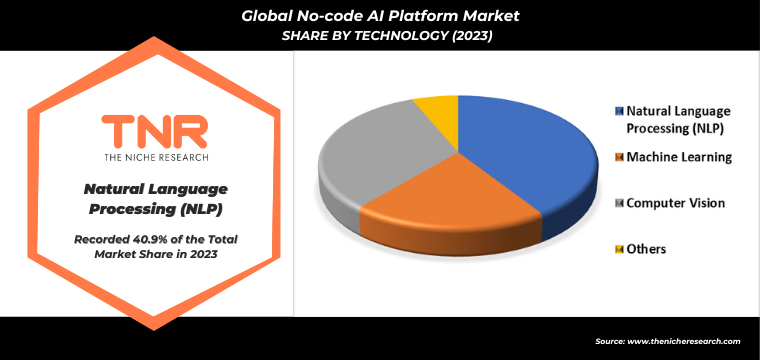
Large enterprises by organization size dominated the no-code AI platform market in 2023. These organizations, with substantial resources and complex workflows, find no-code AI platforms invaluable for accelerating AI adoption without the need for extensive coding expertise. By utilizing these platforms, large enterprises can efficiently automate processes, analyze vast amounts of data, and implement sophisticated AI-driven strategies. The scalability, customization, and integration capabilities of no-code AI solutions cater perfectly to the diverse needs of large enterprises, ensuring they maintain their leadership in innovation and operational efficiency within their respective industries.
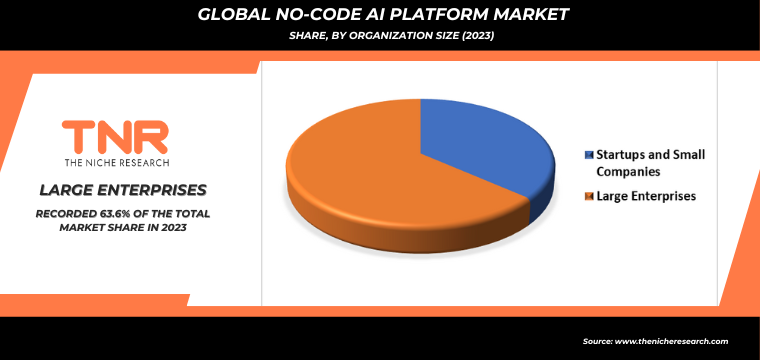
By industry vertical, BFSI is anticipated to grow fastest over the forecast timeline, capturing a revenue share of 17.2% in 2023. This growth is driven by the sector’s increasing need for automation, fraud detection, risk management, and customer service enhancements. No-code AI platforms enable BFSI companies to rapidly develop and deploy AI applications, improving operational efficiency and customer experience without requiring extensive technical expertise. By leveraging these platforms, BFSI organizations can innovate quickly, respond to market changes effectively, and maintain regulatory compliance, thereby driving significant market growth in this vertical.
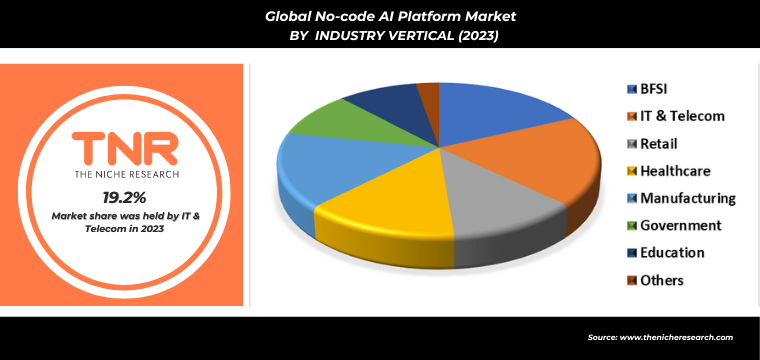
In 2023, Asia Pacific is anticipated to play a significant role in propelling the growth of the no-code AI platform market, contributing approximately 22.5% to its overall expansion. This surge is fueled by the region’s rapid digital transformation, increasing investments in AI technology, and a burgeoning startup ecosystem. Countries like China, India, and Japan are at the forefront, driven by strong government support and a growing demand for AI-driven solutions across various industries. The adoption of no-code AI platforms in Asia Pacific is accelerating as businesses seek to enhance operational efficiency, innovate faster, and gain competitive advantages, positioning the region as a key player in the market’s global expansion.
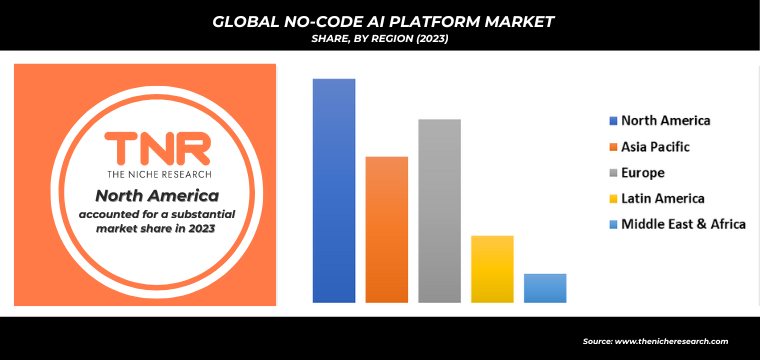
Key Developments
- In October 2023, CyborgIntell, a leading provider of AI solutions, launched two innovative products designed for the BFSI sector: Feature Store and Model Risk Management (MRM). Feature Store, a no-code AI platform, streamlines the creation of numerous features from raw data, cutting data preparation time for modeling by 90%. This tool enables financial institutions to deeply analyze transaction details, including behaviors, patterns, habits, preferences, risks, and relationships.
- In October 2023, Akkio Inc. released Generative Reports, an AI-driven tool that quickly converts data into actionable insights. This tool allows small and medium-sized businesses to integrate their data, outline projects, and generate real-time reports automatically. It provides a self-service option to optimize marketing expenditures, lead scoring, revenue forecasting, and improve customer experiences.
Major Players in No-code AI Platform Market
- AgilePoint Inc
- Akkio Inc.
- com, Inc.
- Apple Inc.
- Caspio, Inc.
- Clarifai, Inc.
- DataRobot, Inc.
- Google LLC
- Intersect Labs
- Levity AI GmbH
- Microsoft
- MonkeyLearn
- Quickbase, Inc.
- Other Industry Participants
Global No-code AI Platform Market Scope
| Report Specifications | Details |
| Market Revenue in 2023 | US$ 3.9 Bn |
| Market Size Forecast by 2034 | US$ 79.7 Bn |
| Growth Rate (CAGR) | 31.5% |
| Historic Data | 2016 – 2022 |
| Base Year for Estimation | 2023 |
| Forecast Period | 2024 – 2034 |
| Report Inclusions | Market Size & Estimates, Market Dynamics, Competitive Scenario, Trends, Growth Factors, Market Determinants, Key Investment Segmentation, Product/Service/Solutions Benchmarking |
| Segments Covered | By Component, By Deployment Mode, By Technology, By Organization Size, By Industry Vertical, By Region |
| Regions Covered | North America, Europe, Asia Pacific, Middle East & Africa, Latin America |
| Countries Covered | U.S., Canada, Mexico, Rest of North America, France, The UK, Spain, Germany, Italy, Nordic Countries (Denmark, Finland, Iceland, Sweden, Norway), Benelux Union (Belgium, The Netherlands, Luxembourg), Rest of Europe, China, Japan, India, New Zealand, Australia, South Korea, Southeast Asia (Indonesia, Thailand, Malaysia, Singapore, Rest of Southeast Asia), Rest of Asia Pacific, Saudi Arabia, UAE, Egypt, Kuwait, South Africa, Rest of Middle East & Africa, Brazil, Argentina, Rest of Latin America |
| Key Players | AgilePoint Inc, Akkio Inc., Amazon.com, Inc., Apple Inc., Caspio, Inc., Clarifai, Inc., DataRobot, Inc., Google LLC, Intersect Labs, Levity AI GmbH, Microsoft, MonkeyLearn, Quickbase, Inc. |
| Customization Scope | Customization allows for the inclusion/modification of content pertaining to geographical regions, countries, and specific market segments. |
| Pricing & Procurement Options | Explore purchase options tailored to your specific research requirements |
| Contact Details | Consult With Our Expert
Japan (Toll-Free): +81 663-386-8111 South Korea (Toll-Free): +82-808- 703-126 Saudi Arabia (Toll-Free): +966 800-850-1643 United Kingdom: +44 753-710-5080 United States: +1 302-232-5106 E-mail: askanexpert@thenicheresearch.com
|
Global No-code AI Platform Market
By Component
- Platform
- Services
By Deployment Mode
- On Premises
- Cloud
By Technology
- Natural Language Processing (NLP)
- Machine Learning
- Computer Vision
- Others
By Organization Size
- Startups and Small Companies
- Large Enterprises
By Industry Vertical
- BFSI
- IT & Telecom
- Retail
- Healthcare
- Manufacturing
- Government
- Education
- Others
By Region
- North America (U.S., Canada, Mexico, Rest of North America)
- Europe (France, The UK, Spain, Germany, Italy, Nordic Countries (Denmark, Finland, Iceland, Sweden, Norway), Benelux Union (Belgium, The Netherlands, Luxembourg), Rest of Europe)
- Asia Pacific (China, Japan, India, New Zealand, Australia, South Korea, Southeast Asia (Indonesia, Thailand, Malaysia, Singapore, Rest of Southeast Asia), Rest of Asia Pacific)
- Middle East & Africa (Saudi Arabia, UAE, Egypt, Kuwait, South Africa, Rest of Middle East & Africa)
- Latin America (Brazil, Argentina, Rest of Latin America)
Report Layout:
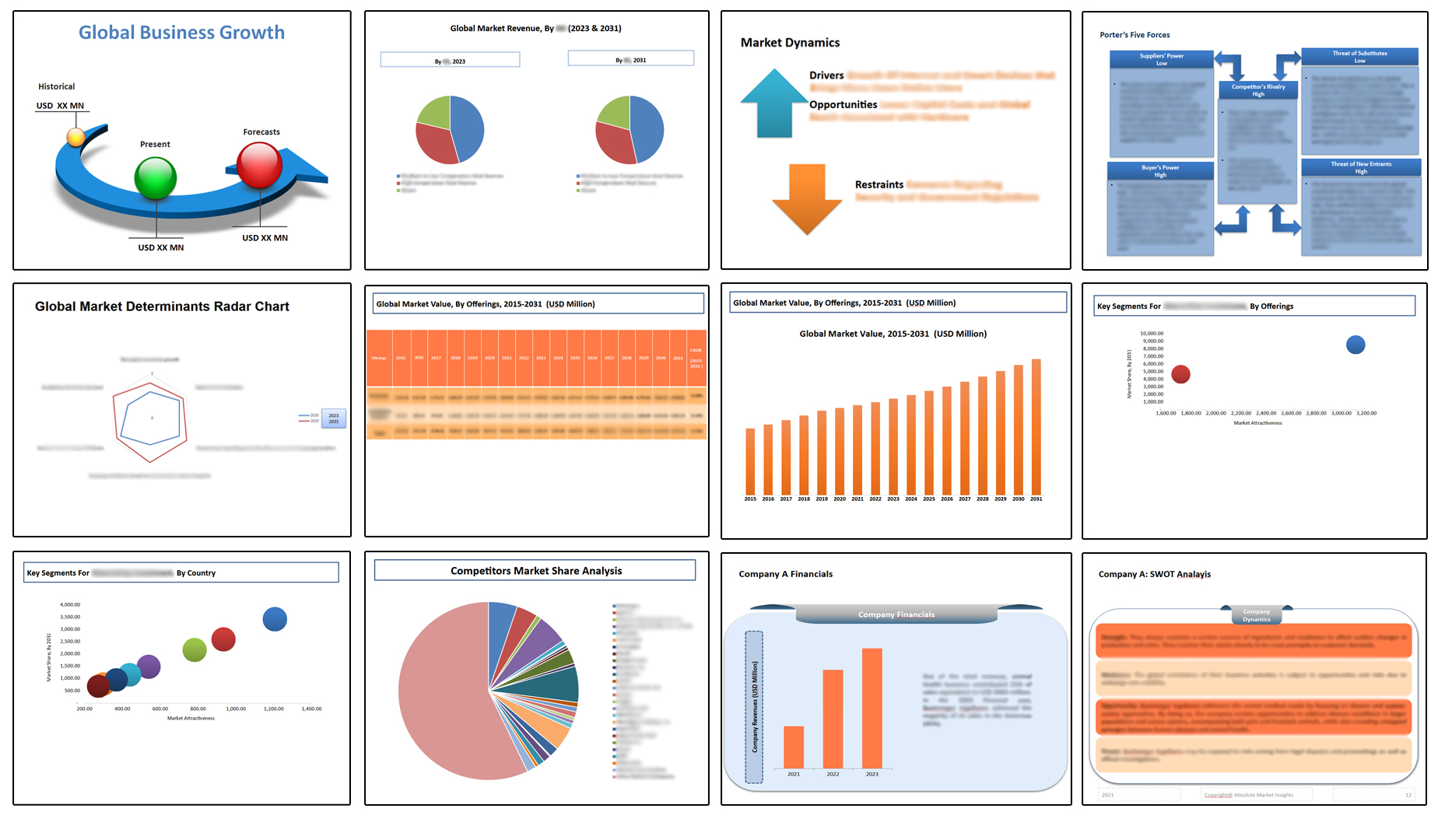
Table of Contents
Note: This ToC is tentative and can be changed according to the research study conducted during the course of report completion.
**Exclusive for Multi-User and Enterprise User.
Global No-code AI Platform Market
By Component
- Platform
- Services
By Deployment Mode
- On Premises
- Cloud
By Technology
- Natural Language Processing (NLP)
- Machine Learning
- Computer Vision
- Others
By Organization Size
- Startups and Small Companies
- Large Enterprises
By Industry Vertical
- BFSI
- IT & Telecom
- Retail
- Healthcare
- Manufacturing
- Government
- Education
- Others
By Region
- North America (U.S., Canada, Mexico, Rest of North America)
- Europe (France, The UK, Spain, Germany, Italy, Nordic Countries (Denmark, Finland, Iceland, Sweden, Norway), Benelux Union (Belgium, The Netherlands, Luxembourg), Rest of Europe)
- Asia Pacific (China, Japan, India, New Zealand, Australia, South Korea, Southeast Asia (Indonesia, Thailand, Malaysia, Singapore, Rest of Southeast Asia), Rest of Asia Pacific)
- Middle East & Africa (Saudi Arabia, UAE, Egypt, Kuwait, South Africa, Rest of Middle East & Africa)
- Latin America (Brazil, Argentina, Rest of Latin America)
The Niche Research approach encompasses both primary and secondary research methods to provide comprehensive insights. While primary research is the cornerstone of our studies, we also incorporate secondary research sources such as company annual reports, premium industry databases, press releases, industry journals, and white papers.
Within our primary research, we actively engage with various industry stakeholders, conducting paid interviews and surveys. Our meticulous analysis extends to every market participant in major countries, allowing us to thoroughly examine their portfolios, calculate market shares, and segment revenues.
Our data collection primarily focuses on individual countries within our research scope, enabling us to estimate regional market sizes. Typically, we employ a bottom-up approach, meticulously tracking trends in different countries. We analyze growth drivers, constraints, technological innovations, and opportunities for each country, ultimately arriving at regional figures.Our process begins by examining the growth prospects of each country. Building upon these insights, we project growth and trends for the entire region. Finally, we utilize our proprietary model to refine estimations and forecasts.
Our data validation standards are integral to ensuring the reliability and accuracy of our research findings. Here’s a breakdown of our data validation processes and the stakeholders we engage with during our primary research:
- Supply Side Analysis: We initiate a supply side analysis by directly contacting market participants, through telephonic interviews and questionnaires containing both open-ended and close-ended questions. We gather information on their portfolios, segment revenues, developments, and growth strategies.
- Demand Side Analysis: To gain insights into adoption trends and consumer preferences, we reach out to target customers and users (non-vendors). This information forms a vital part of the qualitative analysis section of our reports, covering market dynamics, adoption trends, consumer behavior, spending patterns, and other related aspects.
- Consultant Insights: We tap into the expertise of our partner consultants from around the world to obtain their unique viewpoints and perspectives. Their insights contribute to a well-rounded understanding of the markets under investigation.
- In-House Validation: To ensure data accuracy and reliability, we conduct cross-validation of data points and information through our in-house team of consultants and utilize advanced data modeling tools for thorough verification.
The forecasts we provide are based on a comprehensive assessment of various factors, including:
- Market Trends and Past Performance (Last Five Years): We accurately analyze market trends and performance data from preceding five years to identify historical patterns and understand the market’s evolution.
- Historical Performance and Growth of Market Participants: We assess the historical performance and growth trajectories of key market participants. This analysis provides insights into the competitive landscape and individual company strategies.
- Market Determinants Impact Analysis (Next Eight Years): We conduct a rigorous analysis of the factors that are projected to influence the market over the next eight years. This includes assessing both internal and external determinants that can shape market dynamics.
- Drivers and Challenges for the Forecast Period:Identify the factors expected to drive market growth during the forecast period, as well as the challenges that the industry may face. This analysis aids in deriving an accurate growth rate projection.
- New Acquisitions, Collaborations, or Partnerships: We keep a close watch on any new acquisitions, collaborations, or partnerships within the industry. These developments can have a significant impact on market dynamics and competitiveness.
- Macro and Micro Factors Analysis:A thorough examination of both macro-level factors (e.g., economic trends, regulatory changes) and micro-level factors (e.g., technological advancements, consumer preferences) that may influence the market during the forecast period.
- End-User Sentiment Analysis: To understand the market from the end-user perspective, we conduct sentiment analysis. This involves assessing the sentiment, preferences, and feedback of the end-users, which can provide valuable insights into market trends.
- Perspective of Primary Participants: Insights gathered directly from primary research participants play a crucial role in shaping our forecasts. Their perspectives and experiences provide valuable qualitative data.
- Year-on-Year Growth Trend: We utilize a year-on-year growth trend based on historical market growth and expected future trends. This helps in formulating our growth projections, aligning them with the market’s historical performance.
Research process adopted by TNR involves multiple stages, including data collection, validation, quality checks, and presentation. It’s crucial that the data and information we provide add value to your existing market understanding and expertise. We have also established partnerships with business consulting, research, and survey organizations across regions and globally to collaborate on regional analysis and data validation, ensuring the highest level of accuracy and reliability in our reports.









